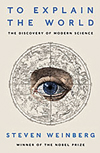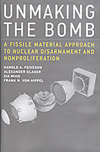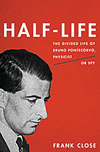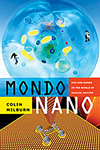Five Fantastic Physics Books
Spring
2016
Connecting Worlds
Five Fantastic Physics Books
Physics Today’s selection of books that stood out in 2015
By:Jermey N. A. Matthews, Associate Editor, American Institute of Physics in College Park, MD
Now in its fifth year, the “end of the year holiday picks” feature highlights five of the most intriguing books that were reviewed in the pages of Physics Today. This year’s emphasis was on books that are broadly accessible.
 To Explain the World: The Discovery of Modern Science by Steven Weinberg (Harper/HarperCollins, 2015; $28.99; 432 pp.). Why did Aristotle not deduce Earth’s sphericity when he saw ships appearing mast-first over the horizon? According to author and physics Nobel laureate Steven Weinberg, it is because the ancients “did not know how to interrogate nature in the systematic way necessary to wring reliable scientific knowledge from it,” writes historian of science and book reviewer Joseph Martin. Instead, Weinberg credits the collective efforts of luminaries of the scientific revolution for launching “the sequence of scientific discovery that continues to this day.… Reconstructions of key discoveries made between Copernicus and Newton lead into his account of what distinguishes the modern scientific attitude from prescientific philosophizing.” To historians, Weinberg’s judgment of history by contemporary standards is “whiggish,” a pejorative term that Weinberg embraces, writes Martin. The publisher’s description on the front flap of To Explain the World goes even further, calling the physicist’s historical account “irreverent.”
To Explain the World: The Discovery of Modern Science by Steven Weinberg (Harper/HarperCollins, 2015; $28.99; 432 pp.). Why did Aristotle not deduce Earth’s sphericity when he saw ships appearing mast-first over the horizon? According to author and physics Nobel laureate Steven Weinberg, it is because the ancients “did not know how to interrogate nature in the systematic way necessary to wring reliable scientific knowledge from it,” writes historian of science and book reviewer Joseph Martin. Instead, Weinberg credits the collective efforts of luminaries of the scientific revolution for launching “the sequence of scientific discovery that continues to this day.… Reconstructions of key discoveries made between Copernicus and Newton lead into his account of what distinguishes the modern scientific attitude from prescientific philosophizing.” To historians, Weinberg’s judgment of history by contemporary standards is “whiggish,” a pejorative term that Weinberg embraces, writes Martin. The publisher’s description on the front flap of To Explain the World goes even further, calling the physicist’s historical account “irreverent.”
 Unmaking the Bomb: A Fissile Material Approach to Nuclear Disarmament and Nonproliferation by Harold A. Feiveson, Alexander Glaser, Zia Mian, and Frank N. von Hippel (MIT Press, 2014; $30.00; 296 pp.). This book presents a timely and scholarly perspective on the issue of controlling highly enriched uranium (HEU) and plutonium, “the essential ingredients of nuclear weapons,” writes nuclear policy expert and book reviewer Matthew Bunn. The book makes clear that “few technical barriers exist to reducing stocks of HEU,” writes Bunn, citing the US program that led, until 2013, to “1 in 10 light bulbs in the US ... being powered by [uranium] from dismantled Russian nuclear bombs.”
Unmaking the Bomb: A Fissile Material Approach to Nuclear Disarmament and Nonproliferation by Harold A. Feiveson, Alexander Glaser, Zia Mian, and Frank N. von Hippel (MIT Press, 2014; $30.00; 296 pp.). This book presents a timely and scholarly perspective on the issue of controlling highly enriched uranium (HEU) and plutonium, “the essential ingredients of nuclear weapons,” writes nuclear policy expert and book reviewer Matthew Bunn. The book makes clear that “few technical barriers exist to reducing stocks of HEU,” writes Bunn, citing the US program that led, until 2013, to “1 in 10 light bulbs in the US ... being powered by [uranium] from dismantled Russian nuclear bombs.”
Plutonium, however, is a different beast: It’s more costly to handle, to secure, and to reprocess into nuclear fuel. The authors recommend, among other options, storing the toxic material in geological repositories. Of relevance to the recent Iran nuclear agreement, the book briefly discusses “‘nuclear archaeology’ techniques that might be useful in determining whether countries’ declarations of how much plutonium and HEU they have match up with the physical evidence from their production facilities.” But by Bunn’s account, it is surprisingly brief on the disarmament verification process; for more on verification, see this Physics Today news report (December 2015, page 26).
 Half-Life: The Divided Life of Bruno Pontecorvo, Physicist or Spy by Frank Close (Basic Books, 2015; $29.99; 384 pp.). A handsome, charming, and ebullient Italian-born physicist, the scion of a wealthy, liberal Jewish family, joins the Communist Party and flees into Russia’s arms during the Cold War. But did Bruno Pontecorvo end up spying for Russia, or did he simply carry out pure research on subnuclear particles? “Physicist Frank Close can conclude only that the spying is likely but not proven,” writes historian of science and book reviewer Spencer Weart.
Half-Life: The Divided Life of Bruno Pontecorvo, Physicist or Spy by Frank Close (Basic Books, 2015; $29.99; 384 pp.). A handsome, charming, and ebullient Italian-born physicist, the scion of a wealthy, liberal Jewish family, joins the Communist Party and flees into Russia’s arms during the Cold War. But did Bruno Pontecorvo end up spying for Russia, or did he simply carry out pure research on subnuclear particles? “Physicist Frank Close can conclude only that the spying is likely but not proven,” writes historian of science and book reviewer Spencer Weart.
According to Weart, “Close does an excellent job of explaining the science and history of nuclear and particle physics” and argues that Pontecorvo, had he still been alive, might have received a share of the 2002 Nobel Prize in Physics for his theoretical work on neutrino oscillation. In bringing “several new source materials to bear,” writes Weart, Half-Life is “the most complete and readable biography of a remarkable individual and his extraordinary response to extraordinary times.”
 Mondo Nano: Fun and Games in the World of Digital Matter by Colin Milburn (Duke University Press, 2015; $28.95 paper; 424 pp.). According to science writer and book reviewer William Atkinson, Mondo Nano employs several “conceptual filters” to explore nanotechnology, including history, military technology, speculative fiction, and video games. The interactive platform of massive, multiplayer online role-playing games allows experts and nonexperts to “rub shoulders” while they “explore the possibilities of new ideas such as combat exoskeletons and artery-cruising nanotherapeutics,” writes Atkinson. Although the scholarly methods of Colin Milburn, a professor of English, cinematographic technology, and science and technology studies, are “not precisely those of the natural sciences,” writes Atkinson, his book is “a thoroughly researched, thought-provoking read that offers many points to ponder.”
Mondo Nano: Fun and Games in the World of Digital Matter by Colin Milburn (Duke University Press, 2015; $28.95 paper; 424 pp.). According to science writer and book reviewer William Atkinson, Mondo Nano employs several “conceptual filters” to explore nanotechnology, including history, military technology, speculative fiction, and video games. The interactive platform of massive, multiplayer online role-playing games allows experts and nonexperts to “rub shoulders” while they “explore the possibilities of new ideas such as combat exoskeletons and artery-cruising nanotherapeutics,” writes Atkinson. Although the scholarly methods of Colin Milburn, a professor of English, cinematographic technology, and science and technology studies, are “not precisely those of the natural sciences,” writes Atkinson, his book is “a thoroughly researched, thought-provoking read that offers many points to ponder.”
 Networking for Nerds: Find, Access and Land Hidden Game-Changing Career Opportunities Everywhere by Alaina G. Levine (Wiley, 2015; $29.95 paper; 248 pp.). In case you’re wondering what the author means by “nerds,” her publisher describes the book as a resource for “established and early-career scientists and engineers.” Expanding on that description, book reviewer Sean Bentley writes that “the aim of her book—to teach students and professionals in science and related fields the networking skills needed to become leaders—is something I have long promoted as an adviser, and director, of the Society of Physics Students and Sigma Pi Sigma.” The book “covers a wide variety of topics, from dinner etiquette to critical tools for making the most of scientific conferences and social media,” writes Bentley. Making her case, author Alaina Levine, founder and president of a leadership-training business and occasional guest blogger for Physics Today Online, notes that professional networking is critical for science because it leads to collaborations and the exchange of ideas. For students and other job-seeking physicists, it might also lead to gainful and rewarding employment.
Networking for Nerds: Find, Access and Land Hidden Game-Changing Career Opportunities Everywhere by Alaina G. Levine (Wiley, 2015; $29.95 paper; 248 pp.). In case you’re wondering what the author means by “nerds,” her publisher describes the book as a resource for “established and early-career scientists and engineers.” Expanding on that description, book reviewer Sean Bentley writes that “the aim of her book—to teach students and professionals in science and related fields the networking skills needed to become leaders—is something I have long promoted as an adviser, and director, of the Society of Physics Students and Sigma Pi Sigma.” The book “covers a wide variety of topics, from dinner etiquette to critical tools for making the most of scientific conferences and social media,” writes Bentley. Making her case, author Alaina Levine, founder and president of a leadership-training business and occasional guest blogger for Physics Today Online, notes that professional networking is critical for science because it leads to collaborations and the exchange of ideas. For students and other job-seeking physicists, it might also lead to gainful and rewarding employment.
To see the full story or purchase a book, visit http://scitation.aip.org/content/aip/magazine/physicstoday/news/10.1063/PT.5.3030.
